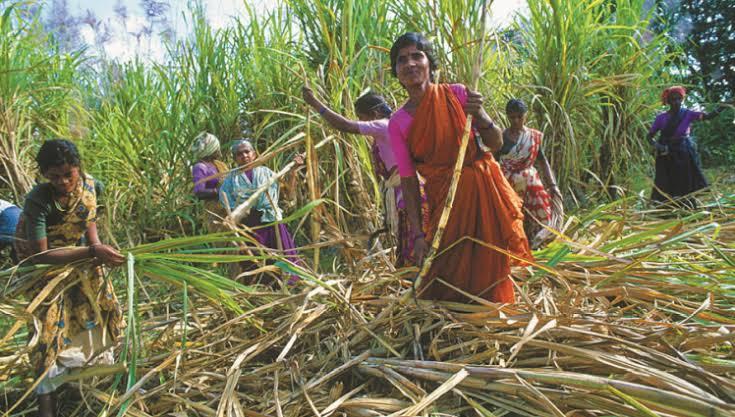Gujarat Tribal Workers Demand Regular Payments, Refuse to Migrate for Sugarcane Harvesting

Dang, a district in southern Gujarat, is witnessing one of the largest labour movements in its recent history after the tribal sugarcane harvesters of the district decided not to migrate to Bardoli and other neighbouring areas. Bardoli, considered a major centre for sugar mills in Gujarat, attracts approximately 1.5 to 2 lakh workers per year from Dang and Tapi districts in Gujarat, and Dhule and Nandurbar districts from neighbouring Maharashtra. These workers are hired for 7 to 8 months in a year to harvest sugarcane for factories. But the terms of hiring have become an untold saga of slavery in modern times.
The workers live on the outskirts of the villages in temporary shelters made from plastic sheets and bamboo sticks, and toil for up to 10-12 hours cutting cane in the fields. Then they are called back to load the harvested sugarcane into trucks. The statutory minimum wage is Rs. 238 per tonne (Mt) of harvested sugarcane that requires 10-12 hours of work by a pair of workers called koyta. In other words, a workers gets Rs 119 per Mt in the state which already ranks among the lowest for minimum wages in India. But the most mind boggling part is related with the advance payments to these workers by their contractors.
Contractors use the system of advance payments that bind workers to the workplace for the duration of the season. This is a common tactic used by employers to ensure a stagnant workforce during the whole work season. The sugarcane workers get an average of Rs. 15,000 advance per pair of workers. They pay back one and half times the amount at the end of the season. The workers are not paid any wages during the season. The settlement of wages is done at the end of the season. Most workers are not left with any surplus funds at the end of the season. The accrued wages get spent in paying back the advance and settlement of expenses incurred during the work season. Thus, forcing them to live a life of misery and debt.
So, how did this system start? Why do these workers travel 100 to 150 kilometres to work in these fields?
Also read: Sugarcane Harvesters In South Gujarat Are Trapped In Bondage, One Generation After Another
Sudhir Katiyar, who works with the Centre for Labour Research and Action, a non-government organisation working for labour rights, sheds light on the phenomenon of labour migration. He told NewsClick, “The annual labour migration started in the late 1970s after the sugar factories denied jobs to local workers. Instead, they hired local contractors, known as Muqadams, to recruit cheap labour from distant lands. So, these contractors travelled to other parts of Gujarat and Maharashtra. They lured tribal workers from Dhule, Nandurbar, Dang and Tapi to harvest sugarcane in the fields. But the migration also exposed their vulnerabilities. Since most of the workers were landless, they became entirely dependent on the money offered by these contractors."
A study conducted by Prayas and Rosa Luxemburg Stiftung noted that the workers are illiterate and constitute the lowest hierarchy of the society. It stated, “Around 80% of the harvesters are in the age group of 21 to 45 years, many of them second or third generation harvesters. A huge proportion of them have been toiling as harvesters for a long time. Almost 50% of them are doing this as a livelihood activity for more than 12 years whereas one-fifth of them for more than 17 years. 80% of them are illiterate. 54% of the migrant harvesters have come from Gujarat state whereas 43% of harvesters are from Maharashtra. Almost the entire workforce comprises of tribals in terms of social identity."
Working Conditions
The report further noted, “Since the early seventies (of last century) wages were paid on a fortnightly basis and advance, too, was deducted in an installment basis every fortnight. On the pretext of inculcating the habit of saving money and not expending it on gambling and liquor consumption among harvesters, the factory management introduced the method of wage payment at the end of the season in the early eighties. And after withholding payment for an entire season, the system of provision of 30 kilos of cereal and allowance of Rs 30 every fortnight was introduced which is still in vogue. It is not difficult to note that the allowance amount remains the same almost forty years since, which strikingly points towards the attitude of management towards poor harvesters."
Explaining this further, Katiyar said that the practice of paying wages at the end of the season has further forced these workers into abject poverty. He said, “Their personal lives are also badly affected. Their children live with them. Their education is ruined as there are no childcare facilities like Anganwadis. Their children too are likely to opt the same practice." The report further corroborates the Katiyar's words.
Also watch: Faster Growth with Gujarat Model Is a Myth: Prabhat Patnaik
It stated, “Another major problem is regarding schooling as well as taking care of their children. As per dataset II of camp-sites every team of 15 koytas has on an average 5 children of school-going age- group of 7-14 years and 8 children below 6 years of age. One-fourth of them are not enrolled, though some of them may be toddlers. But as is mentioned in the earlier study’s qualitative details, even though majority of them are enrolled in schools in native villages, their studies suffer tremendously as they can attend schools for only few months, which in turn, affects their overall education graph detrimentally. Similarly, the children cannot be left on their own at camp-sites when the elders go for harvesting. So they have to be taken along and often they too join their parents in harvesting related labour."
‘Won’t Stop Until All Demands Met’
The struggle of tribal sugarcane harvesters has found an unusual ally in the Muqadams (contractors). Arvindbhai, a Muqadam told NewsClick, "We are contractors for namesake. We also work in the sugarcane fields. We work for almost 12-14 hours per day. Now, this is unacceptable, We cannot work like animals. We demand at least Rs 400 per koyta. I will stand with my mazdoor (labourers)."
The workers have demanded that their payments be made by tripartite boards based on the model of Mathadi Boards of Maharashtra. The Mathadi Boards were constituted in Maharashtra where factory owners pay the wages of workers to boards and board releases the payments later. Simultaneously, the workers also receive their social security benefits like Provident Funds and Bonus.
Get the latest reports & analysis with people's perspective on Protests, movements & deep analytical videos, discussions of the current affairs in your Telegram app. Subscribe to NewsClick's Telegram channel & get Real-Time updates on stories, as they get published on our website.
























